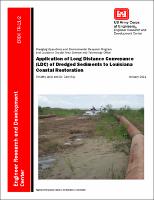Please use this identifier to cite or link to this item:
https://hdl.handle.net/11681/8572| Title: | Application of long distance conveyance (LDC) of dredged sediments to Louisiana coastal restoration |
| Authors: | Welp, Timothy L. Ray, Gary L. |
| Keywords: | Coastal restoration Louisiana Dredging Long distance hydraulic transport Long distance pipeline Louisiana wetlands restoration Marsh creation Pipeline environmental impacts Slurry transport Dredging Operations and Environmental Research Program (U.S.) |
| Publisher: | Engineer Research and Development Center (U.S.) |
| Series/Report no.: | Technical Report (Engineer Research and Development Center (U.S.)) ; no. ERDC TR-11-2 |
| Abstract: | Restoration of Louisiana’s marshes and other coastal habitats will, in many cases, require dredged sediments to provide suitable substrate. Potential restoration sites are often at great distances from the sediment source. It will require special efforts, commonly referred to as long distance conveyance (LDC), to pump sediment to the sites. For the purposes of this report, LDC projects are defined as those Louisiana coastal restoration projects that involve hydraulic transport of slurry (mixture of sediment and water) through pipeline distances of 16 km (10 miles) or greater. Pumping slurry through a long pipeline is a mature technology for bulk transport that has been used efficiently in specific applications like coal and iron ore transport. At the workshop entitled “Long-Distance Pipeline Transport of Dredged Material to Restore Coastal Wetlands of Louisiana,” the consensus of panelists and the audience (that consisted of national and international experts in the field of long-distance transport of dredged sediment and other materials by pipeline) was that there were no fundamental technological challenges to the delivery of sediment via LDC (Hales et al. 2003). The engineering challenges will be to optimize LDC design, operation, and maintenance to achieve respective strategic restoration goals in the most efficient, cost-effective, and environmentally acceptable manner possible. Technical literature was reviewed and interviews with personnel involved in LDC-related projects conducted to summarize state-of-practice LDC dredging project information. Dredging and transport methodologies in relation to LDC state-of-practice are presented, and potential environmental impacts of long distance pipeline transport across wetlands are discussed. Scientific and engineering uncertainties related to LDC optimization of dredged sediment for coastal restoration are identified. Uncertainty, as used in this context, implies a lack of predictability, structure, and information (Rogers 1995). The report’s objective is to identify these uncertainties to personnel involved in planning, designing, constructing, monitoring, and assessing future LDC demonstration projects. If efforts are applied to reduce the levels of these uncertainties in future LDC demonstration projects by applying an adaptive management approach, then the increased predictability, structure, and information gained from these demonstrations may be used to optimize subsequent full-scale LDC Louisiana coastal restoration projects. |
| Description: | Technical Report |
| Gov't Doc #: | ERDC TR-11-2 |
| Rights: | Approved for public release; distribution is unlimited. |
| URI: | http://hdl.handle.net/11681/8572 |
| Appears in Collections: | Technical Report Technical Report |
